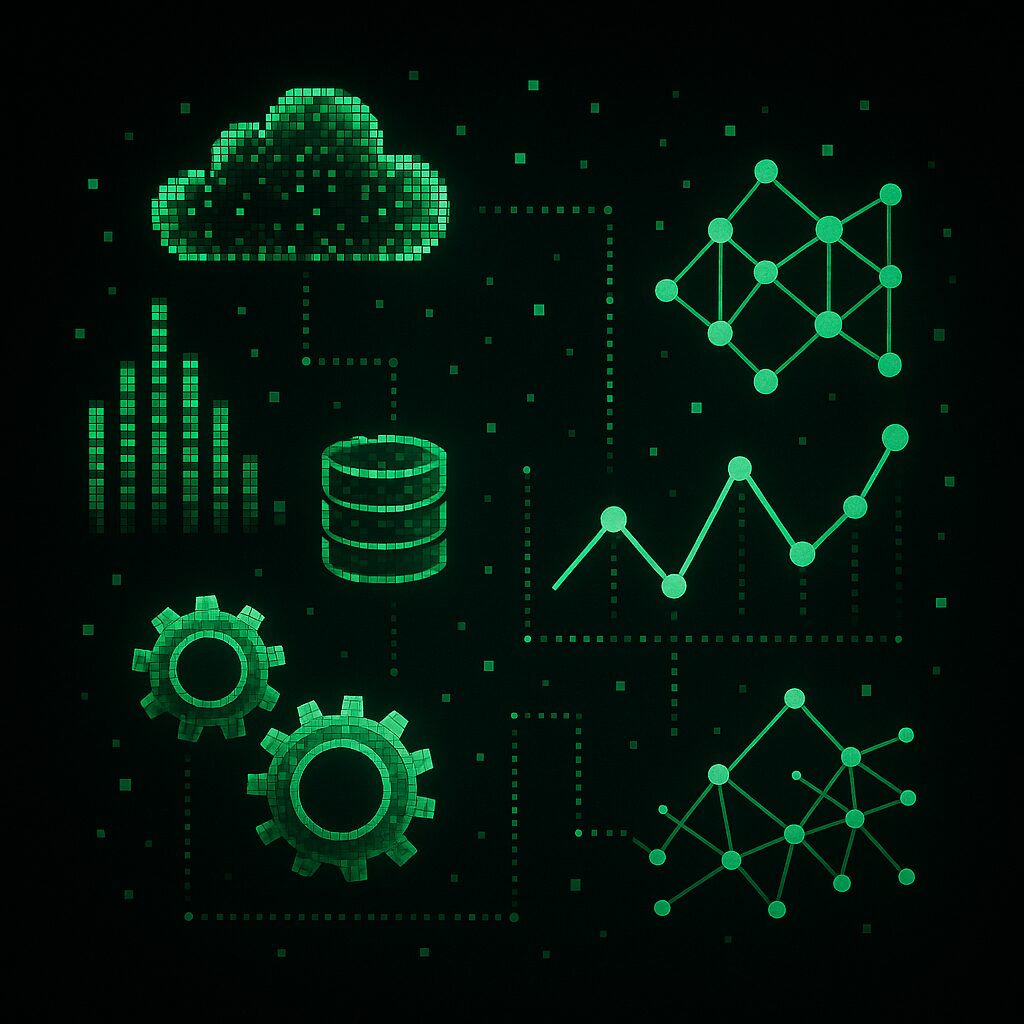Services
AI Solutions
AI Solutions

Services
Generative AI Product Design
We shape ideas into clear, feasible products that deliver value to our customers.
In practice
-
Define target users, core jobs to be done, and success metrics.
-
Select model options (for example, hosted foundation model, fine-tuned model, or retrieval-augmented approach) based on data sensitivity, latency, and cost.
-
Draft conversation flows and interaction patterns for chat, summarization, extraction, content drafting, and decision support.
Example
A customer support portal adds a guided assistant that drafts accurate responses from existing knowledge articles and past tickets, reducing agent handling time by thirty percent.
Retrieval-Augmented Generation (RAG)
We connect models to your private knowledge safely and reliably.
In practice
-
Build secure connectors to document stores, data warehouses, and application programming interfaces.
-
Design chunking, embedding, and indexing strategies that preserve context and prevent leakage.
-
Introduce guardrails that restrict retrieval to the right collections and enforce user permissions.
Example
A professional services firm enables consultants to query proposals, project notes, and legal clauses. The assistant cites sources and respects document access rights.
AI Agents and Orchestration
We design semi-autonomous agents that can plan tasks, call tools, and work together.
In practice
-
Break complex workflows into agent roles such as planner, researcher, writer, reviewer, and publisher.
-
Integrate tools for search, databases, spreadsheets, code execution, and ticketing systems.
-
Add human-in-the-loop checkpoints for sensitive steps and policy compliance.
Example
A marketing team uses a campaign agent that drafts a plan, gathers product facts, writes first versions of assets, requests human review, and schedules approved items.
Prompt Engineering and Evaluation
We create robust prompts and templates, then measure quality with automated tests and human review.
In practice
-
Design reusable prompt patterns and system instructions for different tasks and tones.
-
Build golden datasets with expected outputs to run automated evaluations.
-
Compare versions with side-by-side review and collect structured feedback.
Example
A knowledge assistant improves answer accuracy by establishing a test set of one hundred real questions and running a weekly evaluation when content changes.
Safety, Policy Controls, and Compliance
We implement safety measures and governance so that teams can innovate with confidence.
In practice
-
Configure content filters for toxicity, personal data, confidential terms, and hallucination risk.
-
Add approval workflows, usage policies, and retention rules for prompts, context, and outputs.
-
Produce explainability summaries and audit trails for internal and regulatory reviews.
Example
A health care provider blocks prohibited content, masks personal data in logs, and keeps a complete history of prompts and responses for audit purposes.
Operations at Scale (GenAI Operations)
We run generative systems with the same discipline used for critical software.
In practice
-
Instrument cost, latency, quality, and safety metrics; set alerts and budgets.
-
Introduce release strategies for prompts and chains with rollback and version control.
-
Optimize model selection, caching, batch processing, and autoscaling.
Example
An e-commerce assistant keeps average response time under two seconds during peak traffic by caching frequent answers and routing tasks to the most efficient model.
DELIVERABLES
- Product Vision & Roadmap
- Reference Architecture for Generative AI
- Secure Retrieval Layer
- Agent Blueprints & Tool Adapters
- Prompt Library & Evaluation Suite
- Safety & Policy Pack
- Operation Runbooks & Dashboards
- Launch Playbook & Knowledge Transfer
Clear goals, user stories, interaction flows, and a ninety-day plan with milestones.
A complete diagram and narrative showing data sources, retrieval layer, vector index, model endpoints, safety filters, analytics, and security boundaries.
Connectors, chunking and embedding pipelines, vector index configuration, and permission checks. Includes tests that verify that only allowed documents are retrieved.
Role definitions, planning strategy, and code adapters for search, databases, spreadsheets, ticketing, and external services. Includes manual override and approval steps.
Versioned prompts with descriptions, usage examples, and expected behaviors. Automated tests, quality dashboards, and guidelines for human review.
Safety configuration, policy rules, explainability summaries, and audit procedures that document who can change what and when.
Monitoring views for cost, latency, throughput, error rates, and quality. Runbooks that describe how to investigate incidents, roll back a release, or update a prompt safely.
Step-by-step checklist for release, acceptance criteria, and training sessions for product owners, engineers, and support staff.
ENGAGEMENT EXAMPLES
2-3 weeks
Goal: Select a valuable use case and produce a production-ready design.
Activities
-
Stakeholder interviews and success metric definition
-
Content and data assessment for retrieval-augmented design
-
Low-fidelity prototypes of conversation flows and agent roles
-
Architecture decisions and cost model
Outcomes
-
Product vision, wireflows, and a ninety-day plan
-
Decision record for model selection, data handling, and safety rules
Illustrative result
A field-service company chooses a technician assistant that answers repair questions from manuals and past cases, with strict permission checks.
6-12 weeks
Goal: Deploy a secure assistant that answers from private knowledge with strong grounding.
Activities
-
Build secure connectors and indexing jobs
-
Implement retrieval, re-ranking, and answer verification
-
Add feedback capture and review workflow
Outcomes
-
Assistant embedded in the intranet and help centre
-
Dashboards for quality, feedback, and deflection rate
Illustration
A support assistant reduces ticket volume by guiding users to precise steps extracted from manuals and prior resolutions.
4-8 weeks
Goal: Build reliable operations around existing generative tools.
Activities
-
Instrument prompts and responses, capture feedback
-
Create evaluation datasets and quality gates
-
Establish cost controls and rate limits
Outcomes
-
Predictable quality with controlled spend
-
Faster and safer release cycles for prompt and model changes
Illustration
A marketing content generator reduces rework by checking brand tone, sensitivity, and reading level before content is published.
4-8 weeks
Goal: Reduce risk and accelerate approvals for new initiatives.
Activities
-
Data classification and redaction strategy
-
Policy definition, content filters, and audit logging
-
Documentation pack for internal review
Outcomes
-
Clear governance model and evidence trail
-
Faster sign-off with fewer review cycles
Illustration
A legal department adopts a research assistant after reviewers receive a transparent view of sources, redactions, and decision logs.
Machine Learning Solutions
Machine Learning Solutions

Services
Strategy and Use-Case Discovery
We help you identify high-value opportunities where Machine Learning can create measurable impact. Together we define success criteria, technical feasibility, and a clear path to production.
In practice
-
Map business objectives to candidate use cases such as demand forecasting, churn prediction, fraud detection, and recommendation systems.
-
Score use cases across expected impact, data readiness, complexity, and time to value.
-
Select a pilot that balances risk and reward, for example a lead-scoring model that routes sales efforts toward the most promising prospects.
Example
A services company with many inbound leads reduces response time and increases conversion by prioritizing the top twenty percent of leads based on predicted win probability.
Data and Feature Engineering
We design and build robust data pipelines that are the foundation for reliable Machine Learning. This includes ingestion, validation, transformation, and feature creation.
In practice
-
Connect to operational systems and data warehouses; standardize formats and enforce data quality checks.
-
Create features that improve predictive power, for example lagged metrics, rolling windows, seasonality indicators, and text embeddings.
-
Establish a feature catalog with clear ownership and documentation so that teams can reuse high-quality features.
Example
For a subscription platform, we build a daily pipeline that aggregates login frequency, product usage depth, and support ticket sentiment into features that drive a churn prediction model.
Model Development and Validation
We design, train, and evaluate models that are fit for purpose and easy to maintain.
In practice
-
Start with strong baselines and progressively evaluate more sophisticated methods when they are justified by results.
-
Use rigorous validation that mirrors real-world conditions, including time-based splits for time series forecasting and stratified splits for imbalanced classification.
-
Document performance and limitations in clear language for both technical and non-technical stakeholders.
Example
A retailer’s demand forecast improves replenishment planning by combining gradient-boosted trees with seasonality features, reducing stock-outs without increasing inventory.
Operationalization and Lifecycle Management
We make Machine Learning part of your day-to-day operations, not an experimental island.
In practice
-
Package models for consistent deployment to your preferred environment, such as a container platform or a serverless endpoint.
-
Automate training, evaluation, and deployment with quality gates. A model only progresses when it meets agreed thresholds for accuracy, fairness, and latency.
-
Monitor model behavior in production, including data drift, prediction quality, and service availability, and define playbooks for rollback and retraining.
Example
An insurance provider deploys a pricing model with automatic hourly monitoring of input drift. When drift is detected, the system triggers an alert, schedules a retraining job, and requires human approval before promotion.
Performance, Cost, and Reliability Optimization
We help you reach service-level objectives while controlling operational costs.
In practice
-
Profile end-to-end latency and remove bottlenecks in feature generation, model inference, and data access.
-
Right-size compute for training and serving; use techniques such as model quantization and efficient feature stores to reduce costs.
-
Build graceful degradation strategies so that critical journeys continue to work even during upstream incidents.
Example
A real-time risk scoring service reduces median response time from 450 milliseconds to 120 milliseconds by caching features and simplifying the feature pipeline for online requests.
Governance, Security, and Compliance
We build Machine Learning with trust and accountability from the start.
In practice
-
Implement access controls, encryption, and key management for data and models.
-
Provide explainability reports so that product owners and compliance teams can understand the drivers behind predictions.
-
Maintain auditable records of datasets, training runs, approvals, and deployments.
Example
A financial institution launches a credit decision support model with clear explanations of factor contributions on each decision, enabling fair-lending reviews and faster sign-off.
DELIVERABLES
- Use Case Portfolio & Roadmap
- Reference Architecture
- Data & Feature Catalog
- Training & Evaluation Pipelines
- Model Cards & Decision Logs
- Production-Ready Services
- Runbooks & Operating Procedures
- Security & Compliance Pack
A prioritized list of Machine Learning opportunities with impact estimates, technical prerequisites, risks, and a ninety-day execution plan.
A diagram and narrative describing the end-to-end flow: data sources, pipelines, feature store, training environment, model registry, deployment targets, monitoring stack, and security boundaries.
A browsable inventory of approved datasets and features, including business definitions, owners, data quality rules, refresh cadence, and usage examples.
Code and configuration to train and evaluate models on demand. Includes controlled random seeds, consistent environments, and automated reports that compare candidate versions.
Human-readable documents that explain model purpose, training data, performance across segments, known limitations, and a changelog of design decisions.
Container images or serverless functions for inference, health checks, and observability. Includes structured logging, metrics, and dashboards for latency, throughput, error rates, and prediction quality.
Step-by-step guides for on-call teams and product owners: how to investigate drift, how to roll back safely, how to request a retraining, and how to evaluate a new model candidate.
Evidence for governance: access reviews, encryption policies, data retention rules, and explainability summaries suitable for internal audits and regulatory inquiries.
ENGAGEMENT EXAMPLES
- Discovery Sprint
- Pilot to Production
- Managed ML Ops
- Performance & Cost Optimization
- Governance & Explainability
2-3 weeks
Goal: Identify a high-value pilot and agree on a path to production.
Activities
-
Stakeholder interviews to understand desired outcomes and constraints
-
Data landscape review to assess readiness and quality
-
Scoring framework to prioritize use cases
-
Target architecture outline and effort estimate
Outcomes
-
Use-case portfolio and a clearly defined pilot
-
A ninety-day roadmap with milestones, risks, and mitigation strategies
Illustrative result
A business-to-business software company selects a churn prediction pilot with a clear return on investment, a feasible data pipeline, and a path to integrate with the existing customer success workflow.
6-12 weeks
Goal: Build an end-to-end Machine Learning solution that solves one real problem and is ready for ongoing operations.
Activities
-
Implement a reliable data pipeline and feature set
-
Train baseline and improved models with rigorous validation
-
Package the inference service and deploy to the chosen environment
-
Set up dashboards and alerts for data drift, accuracy, and latency
-
Conduct user acceptance testing with business stakeholders
Outcomes
-
A production-ready service with documented performance and limitations
-
Runbooks and ownership handover to application and operations teams
Illustrative result
A retailer deploys a demand forecast service that improves in-stock rates while reducing overstock. The planning team uses a dashboard to review forecast accuracy by product family and region.
Goal: Keep models accurate, reliable, and cost-effective over time.
Activities
-
Scheduled retraining and evaluation jobs with human approval gates
-
Continuous monitoring of data drift, service health, and cost
-
Quarterly architecture reviews to reduce complexity and spend
-
Incident response exercises and tabletop drills
Outcomes
-
Stable service performance with predictable cost
-
Faster learning cycles and safer rollouts of new versions
Illustrative result
A payments provider maintains a fraud detection model that adapts to seasonal shopping patterns without sacrificing approval rates. Alerts and weekly reports keep risk and product teams aligned.
2-4 weeks
Goal: Reduce latency and operating cost while keeping accuracy stable.
Activities
-
End-to-end profiling of data access, feature generation, and inference
-
Model and infrastructure tuning, including caching and lightweight representations
-
Load testing and resilience testing to validate improvements
Outcomes
-
Documented reductions in response time and infrastructure cost
-
Clear guidance on capacity planning for future growth
Illustrative result
An online marketplace reduces average inference latency by more than half and cuts serving cost by a third by introducing a feature cache and simplifying the model ensemble.
2-6 weeks
Goal: Build trust, transparency, and compliance into Machine Learning.
Activities
-
Define approval workflows and access controls for data and models
-
Produce explainability reports for business reviewers
-
Create audit-ready documentation and evidence trails
Outcomes
-
Faster internal approvals with fewer surprises
-
Reduced compliance risk and clearer accountability
Illustrative result
A lender introduces decision summaries for underwriting. Business reviewers can see which factors contributed most to each decision, which speeds up oversight without manual deep dives.
Technical Support

We provide a flexible remote support and advisory for your data infrastructure with no strings attached. Check out our Database Infrastructure and Big Data Infrastructure pages for more information on the technologies we support.
This could be a critical performance issue, a technical question, a coding question, a security incident… we are there to help.
Contact us for more information on our support plans.
GDPR, Data Protection, Data Privacy and Risk Management – Strategic Consulting
Strategic & Management Consulting

Aleph Technologies has a strong expertise in technology domains such as database and big data, however, this expertise comes in pair with business experience over the years supporting projects and customers in a range of business domains such as Electricity & Utilities, Telco, Healthcare, Public Services, Media and Internet. It is therefore with confidence that we can advise our customers in the following areas :
Infracture Assessment & Evolution Advisory
How well the technology in place does support the business objectives ? How well does it age out ? How reliable is it under increasingly demanding business requirements ? It’s worth the money sticking with vendor X ? What if I migrate to solution Z ? We make an assessment of your existing data infrastructure and align it with your business objectives. We work together to establish a roadmap towards an infrastructure that better support your business objectives.
To do this, we help you get a view of your data landscape by identifying trends in volumes and KPI’s. With the right set of metrics we align with your business goals to make sure your infrastructure will be able to support them. We provide you with advise to upgrade your infrastructure and/or seek for technologies more apt for your future situation. We make an impact assessment of changes you’d require and help you estimate the risks involved.
As technology agnostics, we focus on your requirements and goals, not on particular vendors. We master propietary database technologies as well as open source ones and we know which kind of infrastructure works well with which workload.
Data Protection and Privacy Advisory
Are you ready for the EU General Data Protection Regulation going to be implemented quite soon, 25 May 2018 ? Have you identified sensitive data across your data infrastructure ? Have you identified potential data breaches ? Do you know how to implemente technical measures to comply with EU GDPR ? We help you comply with EU GDPR and avoid your company to face potentially high penalities in case of non-compliance.
We team with your as technical experts to implement technical solutions in order to get your compliant with GDPR.
Key GDPR Data Security Requirements
Risk Assessment
Security Risk Assessment: Controllers must carry on a Data Protection Impact Analysis on sensitive Personal Data and have to provide evidence that Personal Data is safe.
Attack Prevention
GDPR provides a number of techniques to prevent security attacks.
- Encryption: core technology to ensure data is not made accessible to unauthorized parties.
- Anonymization: complete obfuscation of data.
- Pseudonymization: minimize the linkability of data with the actual identity of data subjects.
- Data Minimization: data collection and retention must be minimized to the strictly necessary.
- Access Control: GDPR recommends measures at two levels, namely,
- Privileged users having access to Personal Data must be scrutinized to avoid breaches due to compromised accounts.
- Fine-grained access control to Personal Data ensures data is accessed only for a specific purpose and within a well-defined process.
Monitoring
GDPR not only imposes that all activities on Personal Data must be recorded, it also recommends a centralized audit management by the Controller officer. Moreover, alerting mechanisms must be in place to notify the controller in case of unusual activities on Personal Data.
How do we help you ?
We help on each of the areas discussed in the GDPR. Each of the task and techniques listed below require different tools and technologies depending on your actual infrastructure. We have extensive experience with the security features offered by the major players in the database and data platform ecosystem and we can help you with these concrete aspects.
Risk Assessment
- Personal Data identification
- Access, role and privilege analysis
- Security configuration analysis
Attack Prevention
- Encryption of data and data transfers
- Anonimyzation/Pseudonymization of Personal Data
- Personal Data Access Control
Monitoring
- Audit implementation and centralization
- Audit event notification implementation
Risk Management Advisory
Is your data at risk ? Is your data backup and recovery strategies in line with your business contingency plan ? Is your contingency plan sound and does it cope with new technologies added to your landscape ? Is your data leakable ? We can provide you witn an independant and expert advise on this important and often overlooked topic. Remember : your data is your most valuable asset, take good care of it.
